Shadow model and coverage driven
processor verification using
SystemVerilog
By Arthur Freitas
|
No Comments
|
Posted: June 1, 2007
Topics/Categories: Verified RTL to gates
|
Tags:
PRINT
SHARE
This paper describes a random test generation strategy we are using
to complement the verification of upcoming generations of processor.
SystemVerilog provided the means to define the functional coverage
of our design and to employ the shadow modeling technique,
significantly improving our verification flow. Shadow modeling is
a reliable method for proving the functionality of the design,
because different engineers implement the reference model and the
RTL, and it is very unlikely that two distinct teams, using two
different programming languages, will implement the same errors in
the same way.
The functionality of the microprocessor is already comprised in its
reference model (i.e., the instruction set simulator). The ISS is
considered to be a running specification of our microprocessor.
Although it was not conceived for use in hardware verification, we
are leveraging the investment spent on its creation for this purpose.
In this way, we gained time – otherwise invested to conceive and
�
implement direct tests for difficult corner cases – to specify and
implement the functional coverage of the design. Our verification
software not only substantially improved the verification flow, but
also now gives us virtually unlimited opportunities to further
enhance the verification of the system.
1. Introduction
In earlier generations of Hyperstone microprocessors, we used self-checking directed
tests as our main approach to functional verification. In conjunction with booting the
OS and running some application programs written in C, this was considered sufficient.
As the architecture became more complex, many more test cases had to be covered. So,
we supplemented existing verification methods with random test generation and automated
result checking.
Three independent tasks must be implemented to employ this verification methodology:
1. Random test generation: a stream of random instructions, properly constrained so
they do not put the microprocessor into an illegal state.
2. Reference modeling: a ‘golden’ model used to ensure that the random test run
produces the correct results. The model runs the same test and generates reference
results used for comparison in simulation.
3. Functionalcoverage: a mechanism that measures the functional coverage of the random
tests generated because, unlike with directed test, we do not know in advance what
is being tested and what is not.
These tasks can be implemented in many ways. The next sections describe how we implemented
our verification system based on random test generation and automated result checking.
2. Improving the verification environment
Our original verification environment was based on a simple test-bench that instantiated
the processor RTL code and its behavioral memory models. We had a regression suite based
on directed tests that was combined with the boot simulation of the Hyperstone real-time
kernel and other application programs.
As our architecture became more complex, many more test cases had to be covered. So we
added random test generation and automated result checking. A good random test generator
can generate tests to cover different addressing modes, instruction combinations,
pipeline issues, and so on.
�
Our approach was initially based on perl scripts generating con-strained random assembly
code. This was assembled to create a loadable memory image of the test for the RTL
simulation. The same test had to run in a reference model prior to the RTL simulation
to generate the reference result files. This reference model was a behavioral instruction
set simulator (ISS) written in C. During the simulation, these files were loaded and
used for comparison with the main RTL results. On a mismatch, the simulation was
immediately stopped. To address functional coverage, we used the PSL cover directive
to cover properties defined in the instruction register (IR).
Figure 1.
Shadow modeling
This resulted in an over-complicated verification flow. Automation was cumbersome and
testing was limited to the amount of memory in the system. The longer the test, the bigger
the reference file, and the file IO usually slowed down simulation performance. Because
of the limited test duration, we had to start several simulations, merge the functional
coverage database, and decide if we needed to start a new simulation or not.
We decided to use shadow modeling to improve the flow. This entails integrating the
reference model in logic simulation. As a result, we no longer needed to run tests in
the ISS to generate reference files for the RTL simulation. The results were generated
in simulation on-the-fly by the ISS. To integrate the ISS in logic simulation, we used
SystemVerilog’s direct programming interface (DPI).
Additionally, we substituted the perl scripts with verification soft-ware written in
C. In simulation, instead of loading a memory image of the test containing the random
instructions, we now load the cross-compiled verification software. While executing the
software, the processor generates on-the-fly random machine code, copies it into a memory
�
segment, branches to this segment, and executes the just generated code. After finishing
execution, it repeats this loop over and over again. We are no longer limited by system
memory size. Software running in the device-under-test (DUT) generates and executes its
stimuli indefinitely.
We used SystemVerilog constructs to define and monitor the functional coverage. Thus,
our software could be run indefinitely until it automatically reached the coverage goals.
(see Section 4)
In summary, the verification flow has been simplified to:
1. Compile the verification software into a loadable memory image.
2. Simulate the execution of the verification software until it reaches coverage goals.
Another advantage here is that the verification software is aware of the processor state
and can, on its own, steer the direction of the tests it creates. Previously, we were
not generating tests on-the-fly but in advance and then simply running them in the
microprocessor. These tests had no intelligence: they were simple random code, blindly
executed to perform result comparison with the reference model. Now, there are virtually
no limitations on how we improve the software(e.g., building intelligence to better
constrain the stimuli).
3. Result checking using shadow modeling
Random instruction generation can only be used in verification if the same stream of
instructions is run on a reference model and the results compared against the RTL
implementation. To perform our result checking, we used ‘shadow modeling’. With this
technique, a reference model is simulated in parallel to the DUT. Every time the DUT
completes an instruction, the reference model is assigned to execute the same instruction.
When the reference model finishes executing this instruction, the two results are
compared and mismatches flagged. For verification, the reference model can be an ISS
or a cycle-accurate model of the microprocessor. The results are snapshots of the
microprocessor’s internal register file, which are written every time an instruction
is executed. Figure 1 depicts our system.
3.1 The Reference Model
We used an existing ISS as our reference model. It was a non-cycle accurate simulation
model of the Hyperstone E1-32X microprocessor written in C. It simulates not only the
full instruction set architecture (ISA) but also memories and peripheral circuits. After
every instruction is executed, its entire register file is saved in a set of variables.
Programs are run sequentially; no instruction pipelining nor any timing of the E1-32X
at the hardware level is modeled. The fact that the ISS is not cycle-accurate presents
some challenges, discussed in the next subsection.
�
Figure 2.
Testbench – checking the results
3.2 Integrating the shadow reference model
To integrate our reference model for HDL simulation, we used the SystemVerilog DPI. It
simplifies the task of integrating C-code in logic simulation and offers very good
simulation performance. For the ISS integration, we wrote an interfacing function in
C to hold and transmit the required parameters to the actual ISS. We imported this C
function to the testbench with the following statement: import “DPI-C” context task
ProcessorCall (input int reset, input int intrpt1, … , input int pin1,…);
Once integrated in simulation, the ISS acts like a slave of the test-bench. When called,
it takes control of the simulation to execute one single instruction. When this is
finished, it gives control back to the logic simulator. Instructions executed by the
ISS do not consume simulation time. The ISS is not cycle equivalent to the real system:
multi-cycle instructions (e.g., DIV and MUL) are executed in a single call. Interrupts
are reported to the ISS on every call.
To perform result checking, the DUT and the ISS must run synchronously. We cannot call
the ISS at every clock cycle to execute an instruction because multi-cycle instructions
�
report their results immediately and the program counter (PC) is then actualized,
resulting in a loss of synchronization. So, we created a signal in the microprocessor’s
RTL code that signals when an instruction has finished its execution and has the results
written back to the register file. We named this ‘flag pipe_wb’ (i.e., pipeline write
back) and it triggers the call to our ISS.
3.3 Checking Results
To check results, we use the DPI to import an existing ISS function that returns the
current value of a register in the microprocessor’s register file. We imported this
C function to the test-bench with the following statement: Import “DPI-C” function
int GetReg (input int reg_index); After the ISS is called to execute an instruction,
we call a Verilog task that loops all registers comprised in the microprocessor register
file and compares their contents to those generated by the reference model. There are
exceptions that require special handling. For example, the results of a LOAD instruction
will not immediately be used in the subsequent instruction as a source operand. This
LOAD may take several clock cycles to conclude its execution, and as long as its result
is not required in the current instruction, the processor does not block the program
execution. Yet the ISS does not model this behavior; the result is immediately written
to the destination register. Therefore, we built a mechanism that prevents the comparison
of this register until the result is also available in the DUT.
Before we can compare the registers, we have to pre-initialize them in software. Since
both DUT and ISS run the same test program, they are initialized equally. After
initialization, the processor writes a value to a memory-mapped register in the testbench
to signal that initialization is finished and comparison can start.
Figure 2 illustrates a simplified version of the testbench. Lines 0-2 show import
declarations for the C functions of the reference model, or ISS (we had to import
‘ProcessorCall’ as a ‘context task’ because it calls our ISS, which in turn calls
other functions). Lines 10-20 depict code where the testbench waits until the software
finishes the initialization of all registers in the processor’s register file. The
processor then writes the value 0×12341234 to the ‘MONITOR’ register, which is
memory-mapped to the microprocessor. This sets the signal compare to 1’b1, enabling
the actual register comparison in line 38. Lines 24 -31 depict the actual result
comparison. The signal ‘pipe_wb’ flags when an instruction has written its results
in the processor’s register file. This triggers the call of the reference model
(‘ProcessorCall’) so that it can execute the same instruction and keep in synch with
the DUT. The passed parameters are assigned to global variables of the ISS before the
ISS main function is called to resume the program execution. Before the function returns,
the ISS saves its state in an array of global variables (‘reg[RegIndex]’). Lines 33-51
depict the task ‘Load_Compare’, which loops all registers contained in the
processor’s register file and compares the contents to those generated by the reference
model.
4. Functional coverage
�
Functional coverage measures the functionality exercised in the design and, properly
defined, helps indicate the completeness of the verification plan. It also helps
engineers to identify untested parts of the design and concentrate on reaching the
verification goals within the optimal number of simulation cycles.
We employed SystemVerilog to specify our functional coverage models as it provides many
extensions to facilitate the specification, computation, and monitoring of a system’s
functional coverage. One important coverage goal was to ensure that all instructions
were tested in their most important modes. We used coverage groups to specify the
functional coverage of our entire instruction set architecture (ISA). The Hyperstone
microprocessor has variable-length instructions of 16, 32, and 48 bits. The next two
subsections explain how we used coverage groups to specify functional coverage of the
instruction MOV of the Hyperstone ISA.
Figure 3.
RR instruction encoding
Figure 4.
MOV functionality
Figure 5.
MOV encoding
4.1 Specification for the MOV instruction
The MOV instruction is a 16-bit instruction of format ‘RR’, that means it accepts global
(i.e., G0…G15) or local (i.e., L0…L15) registers as both destination and source
operands. Figure 3 depicts how instructions of type ‘RR’ are encoded in the instruction
register (IR).
In a MOV instruction, the content of a source register is copied to the destination
register, and the condition flags are set or cleared accordingly. Figure 4 depicts its
functionality. ‘Z’, ‘N’, and ‘V’ refer to the zero, negative, and overflow flags,
respectively.
�
The encoding scheme for the MOV instruction is depicted in Figure 5. For example the
assembly instruction ‘MOV G3, L2’ produces the machine code ‘0×2532’, where the
op-code ‘0×25’ indicates that it is a MOV instruction that has a global register as
destination and a local register as source. The remaining byte ‘0×32’ is the
concatenation of Rd-code and Rs-code and indicates that the register indexes are ‘0×3’
for the destination and ‘0×2’ for the source.
4.2 Functional coverage
for the MOV instruction To specify the functional coverage model for the MOV instruction,
we used the code in Figure 6. This counts how many times all the variants of the MOV
instruction have been executed.
Figure 6.
Covergroup for MOV instruction
To collect the coverage information, we defined the coverage group ‘cg_MOV’. We created
three coverage points associated with the signal IR, and two coverage points associated
�
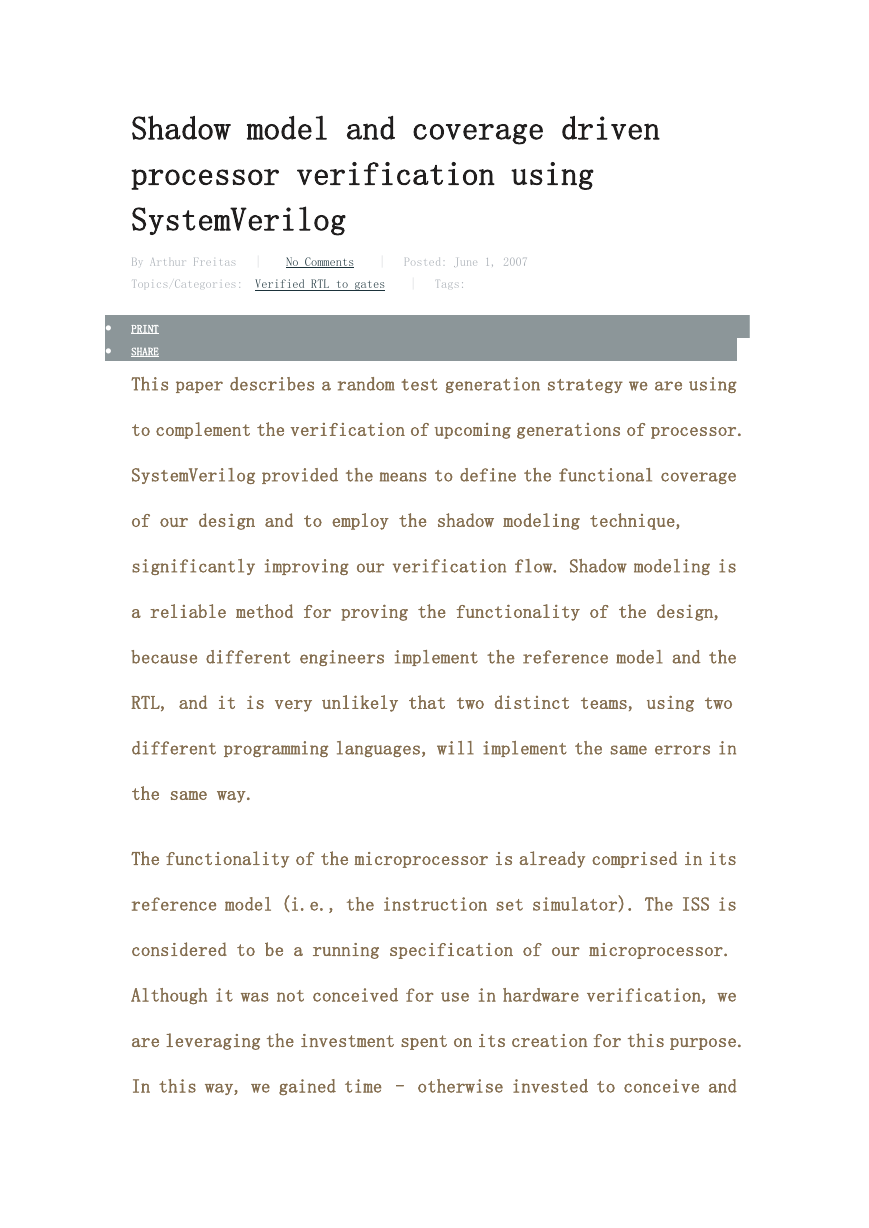
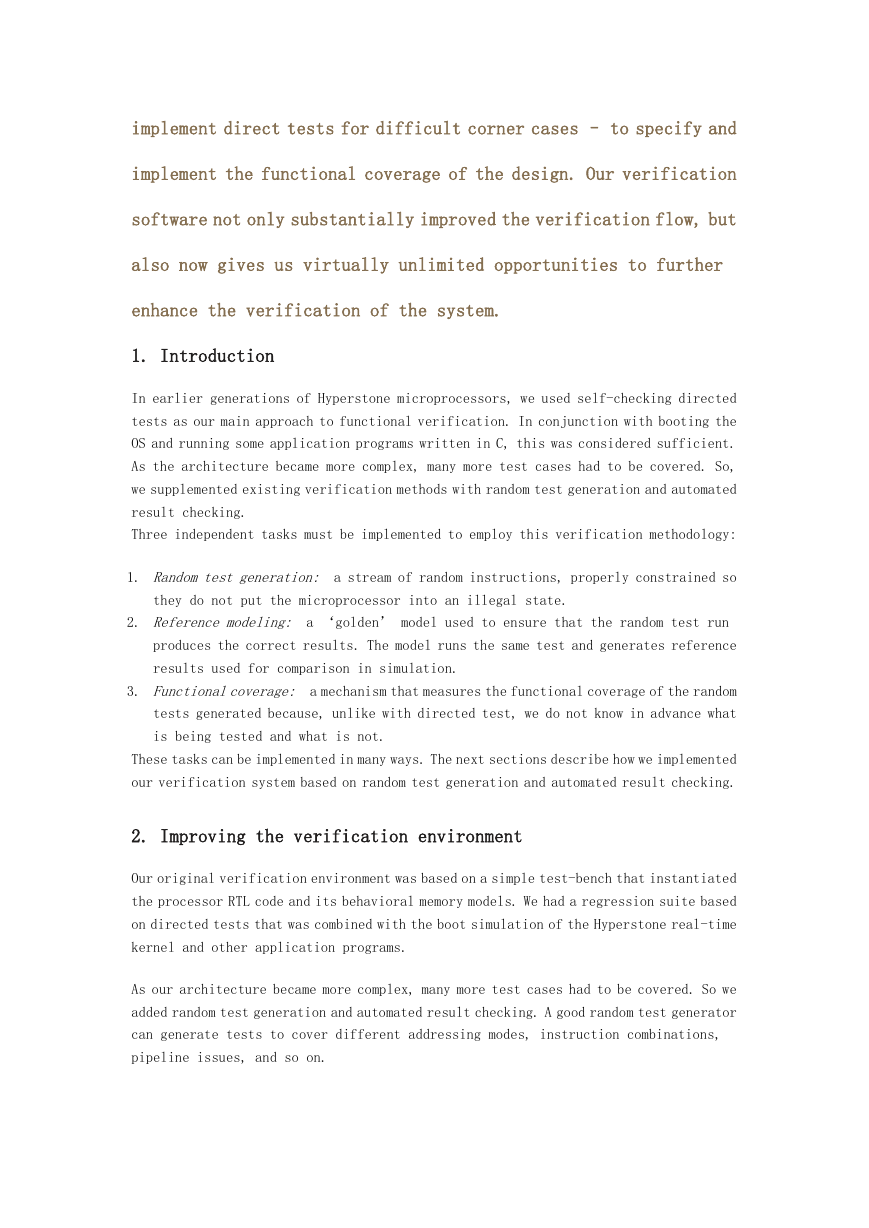
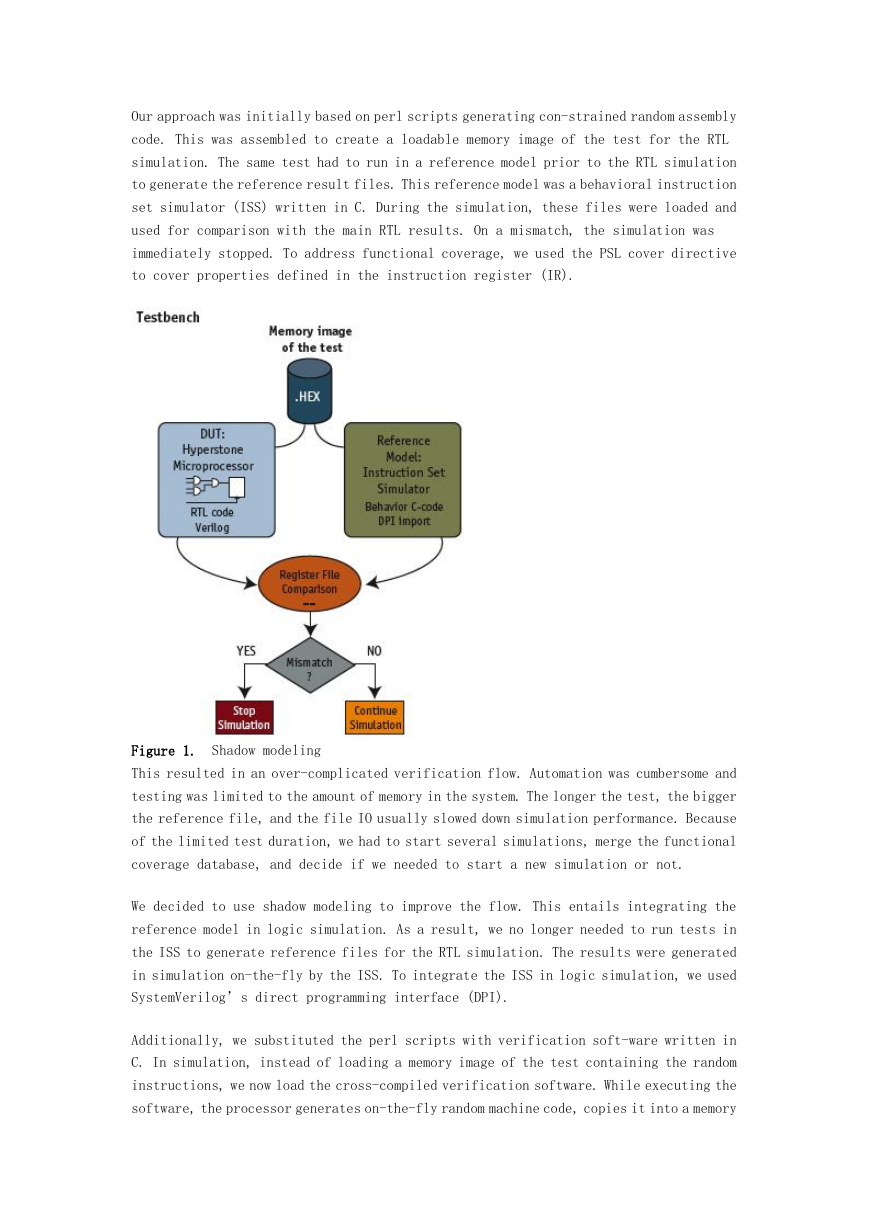
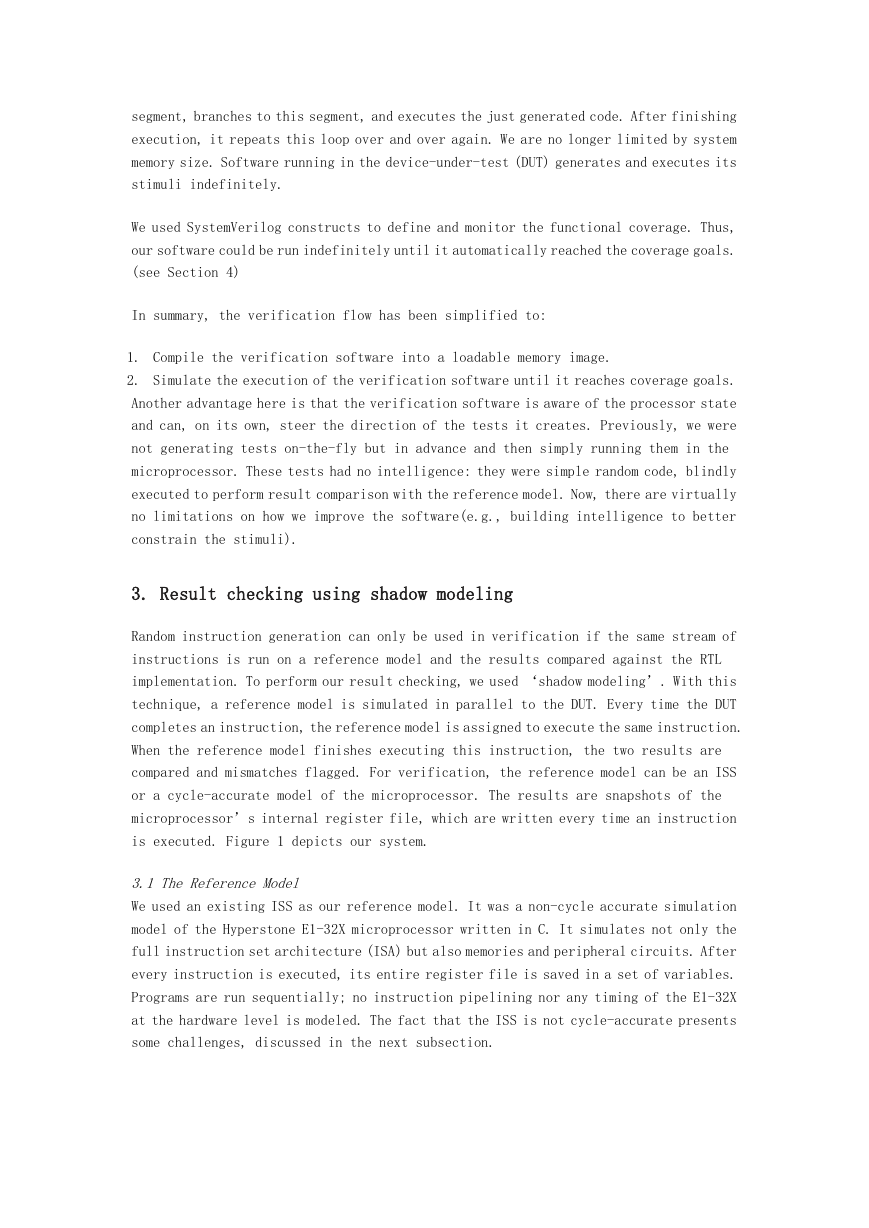
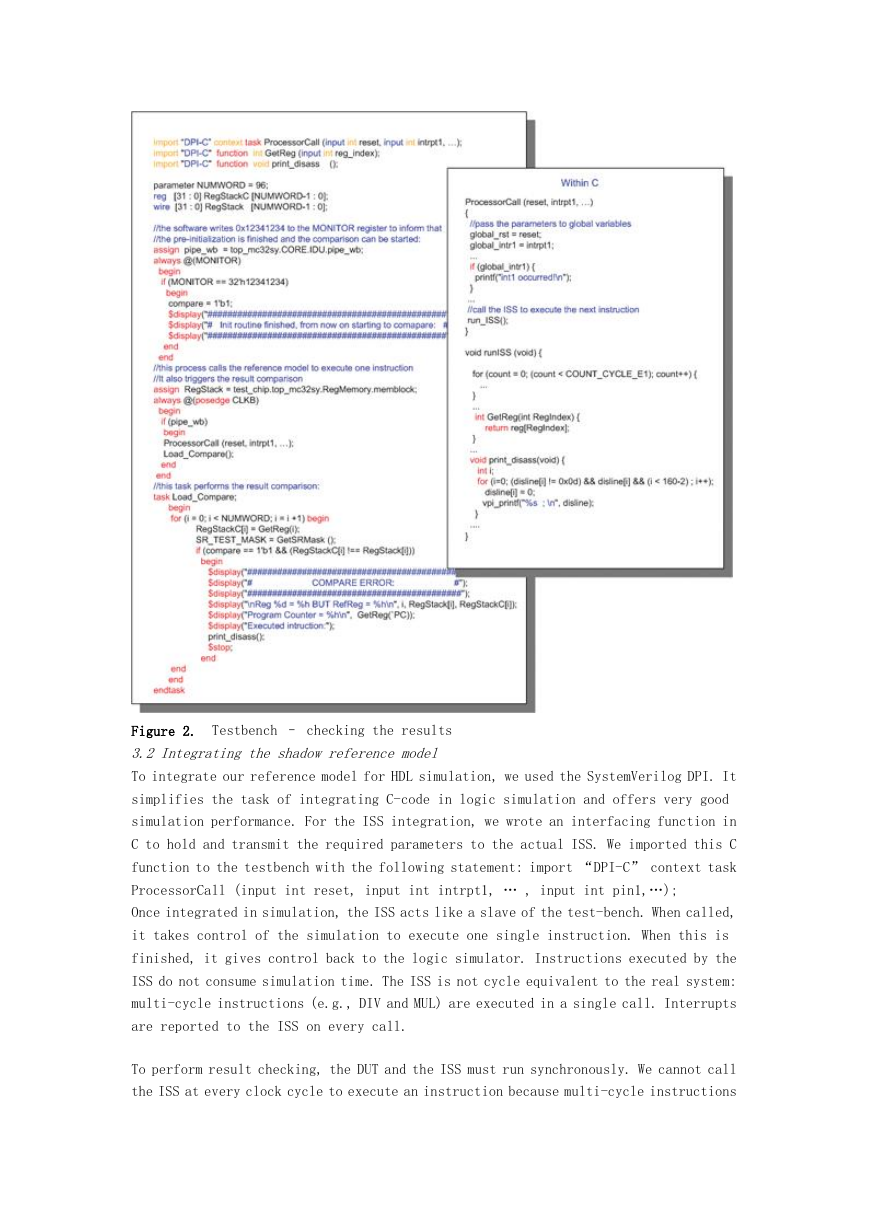
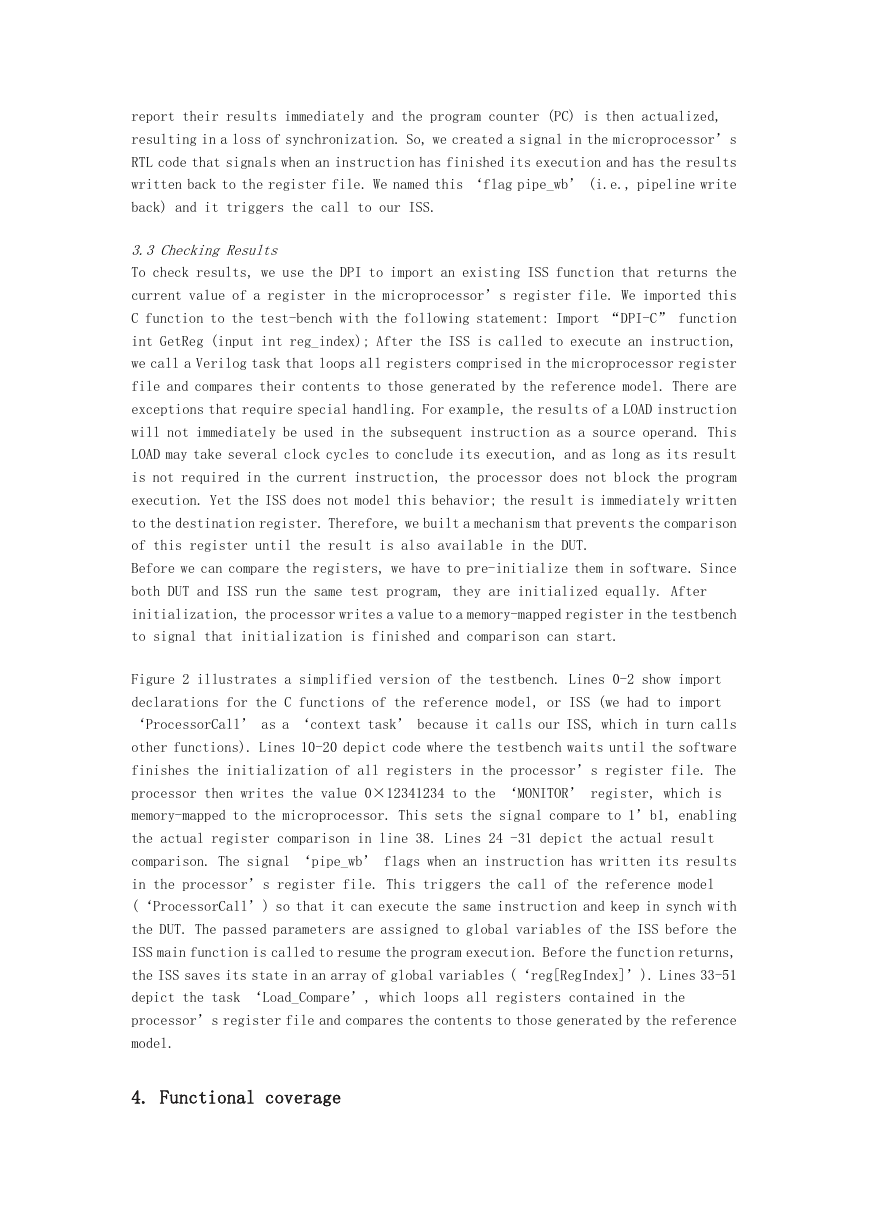

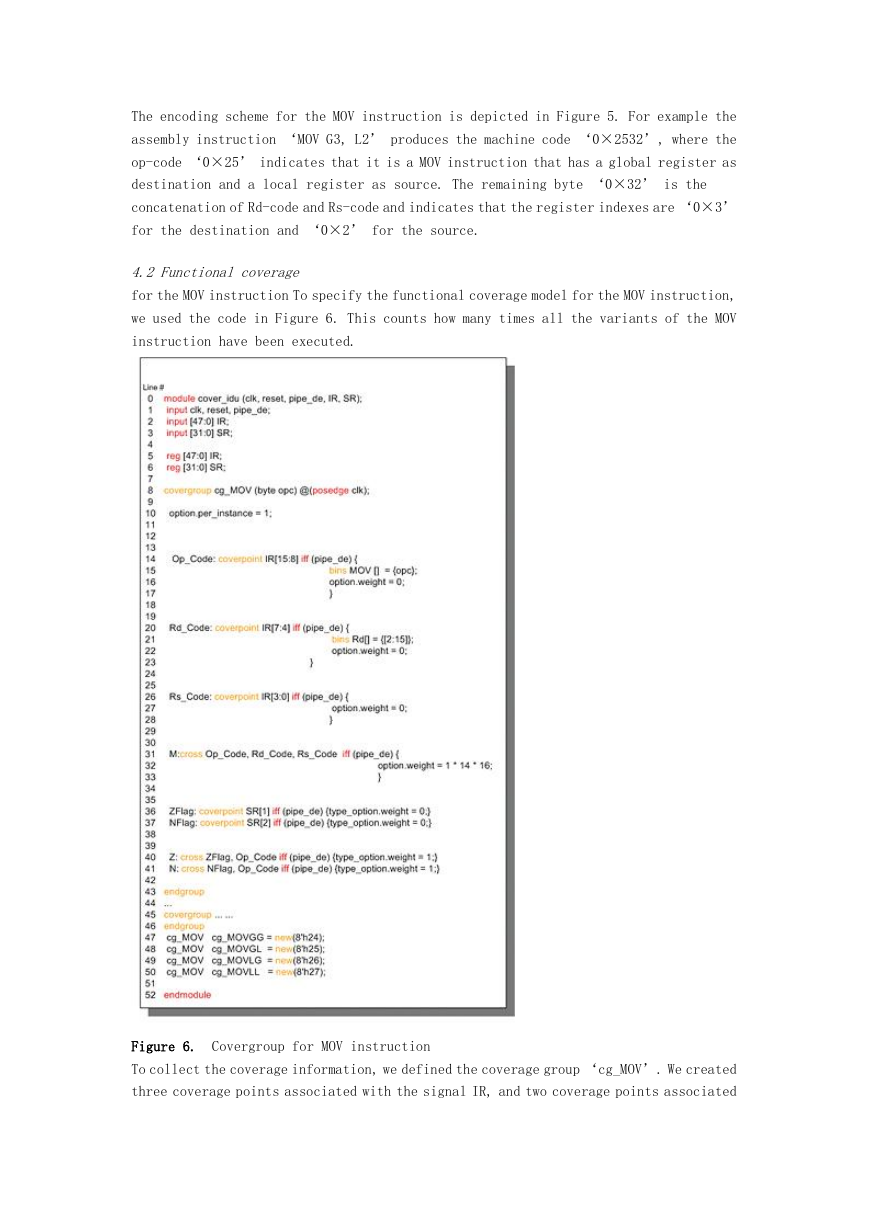








 2023年江西萍乡中考道德与法治真题及答案.doc
2023年江西萍乡中考道德与法治真题及答案.doc 2012年重庆南川中考生物真题及答案.doc
2012年重庆南川中考生物真题及答案.doc 2013年江西师范大学地理学综合及文艺理论基础考研真题.doc
2013年江西师范大学地理学综合及文艺理论基础考研真题.doc 2020年四川甘孜小升初语文真题及答案I卷.doc
2020年四川甘孜小升初语文真题及答案I卷.doc 2020年注册岩土工程师专业基础考试真题及答案.doc
2020年注册岩土工程师专业基础考试真题及答案.doc 2023-2024学年福建省厦门市九年级上学期数学月考试题及答案.doc
2023-2024学年福建省厦门市九年级上学期数学月考试题及答案.doc 2021-2022学年辽宁省沈阳市大东区九年级上学期语文期末试题及答案.doc
2021-2022学年辽宁省沈阳市大东区九年级上学期语文期末试题及答案.doc 2022-2023学年北京东城区初三第一学期物理期末试卷及答案.doc
2022-2023学年北京东城区初三第一学期物理期末试卷及答案.doc 2018上半年江西教师资格初中地理学科知识与教学能力真题及答案.doc
2018上半年江西教师资格初中地理学科知识与教学能力真题及答案.doc 2012年河北国家公务员申论考试真题及答案-省级.doc
2012年河北国家公务员申论考试真题及答案-省级.doc 2020-2021学年江苏省扬州市江都区邵樊片九年级上学期数学第一次质量检测试题及答案.doc
2020-2021学年江苏省扬州市江都区邵樊片九年级上学期数学第一次质量检测试题及答案.doc 2022下半年黑龙江教师资格证中学综合素质真题及答案.doc
2022下半年黑龙江教师资格证中学综合素质真题及答案.doc